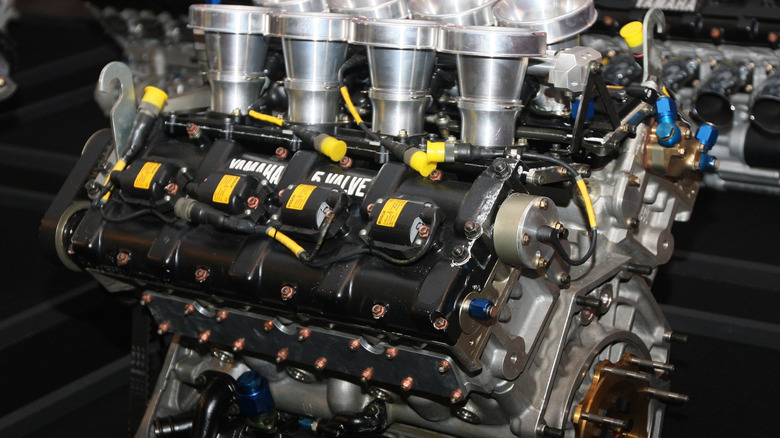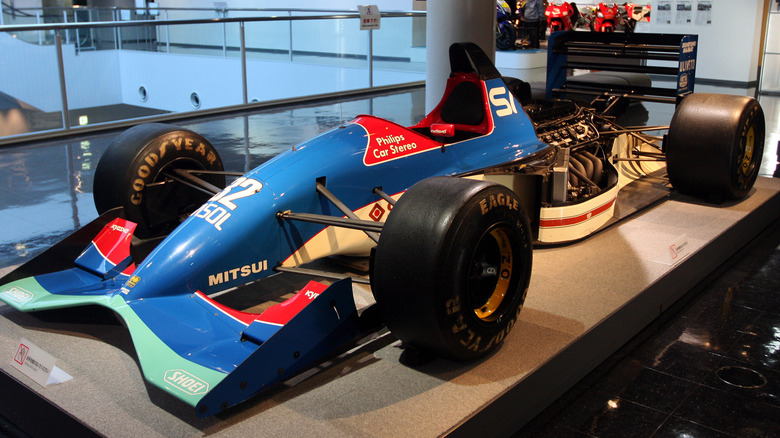Yamaha Used To Make F1 Engines - Here's Why It Stopped
When you think of Yamaha, the last thing that comes to mind is Formula 1 engines. The motorcycle manufacturer ranked impressively high on our worst-to-best motorcycle brand list, which was to be expected, given that it is responsible for marvels such as the beastly YZF-R1 and reliable motors like the TW200 Engine. Yamaha has explored various segments of the vehicle industry over the years, with one of its most underrated contributions being the development of F1 engines. Between 1989 and 1997, the company was heavily involved in the Formula 1 racing scene. It started by teaming up with the then-German racing team, Zakspeed Formula Racing, to form the West Zakspeed Yamaha Team. The company also brought one of its in-house motors, the OX88, a 3,489 cc, 600 horsepower V8 engine, to power its team's racecar.
For nearly a decade, Yamaha would supply engines that would power F1 vehicles, with its engines appearing in 116 races. But why exactly did the company decide to stop? Well, the answer lies squarely in the performance of said engines. The motors Yamaha brought to the F1 track were riddled with reliability issues, which made them underperform against other engines. Today, we are examining Yamaha's eight-year involvement in Formula 1 and how the performance of its motors contributed to its decision to stop supplying engines to the races.
Yamaha's engines seemed to be doomed from the start
Yamaha's involvement in Formula 1 had been troubled since the beginning. The company initially approached the British automotive engineering company Cosworth with a modified version of its OX77 engine, which, on paper, had a performance gain over what Cosworth was using at the time. However, the engine was also heavier, which wasn't a good look for Yamaha. The engine's dyno test was a disaster, thanks to a valve failure, which prevented Corsworth from any deals it would have struck with Yamaha.
As expected, Yamaha forged on. It made several tweaks to its engines and, in 1988, managed to strike a deal with Zakspeed, which had faced its own set of issues in F1. Yamaha slapped on the OX88 into a car and joined the races. However, it was only a matter of time before the engine began to exhibit problem after problem, with some of the most notable being the motor's intake and exhaust valves, which struggled to last through the entire race. Such engine problems would be the main reason why the company would eventually stop producing engines for Formula 1.
Yamaha's performance in the races wasn't the best
Zakspeed only qualified twice in 16 races, culminating in its withdrawal at the end of the year. As for Yamaha, the failures of the OX88 motor weren't enough to completely pull it out of the races. After sitting the 1990 season out, it partnered with British racing car manufacturer and F1 racing team Brabham, presenting the OX99, a V12 engine that would have problems facing V10s just a year later. By then, Yamaha would have already parted ways with Brabham, forming a team with Sasol Jordan. In 1993, Yamaha parted ways with Jordan and moved forward to create its own V10 engine in collaboration with John Judd. The resultant engine, the OX10A, powered most of its racecars after it partnered with Tyrrell, an auto racing team and Formula One constructor, between 1993 and 1996.
Variants of the OX10A, like the OX10B and OX10C, exist down the line, each being some modified version of the OX10A. Yamaha only scored a total of 22 points throughout the first seven years of its career in F1. If you're wondering if that's bad. Yes. That's pretty bad. In contrast, companies such as Renault scored 821 points in those seven years. In its final year, Yamaha teamed up with Arrows before finally throwing in the towel.
Although the engines Yamaha brought to the F1 races seemed good on paper, most had problems, from intake and exhaust valves having performance issues to engine blocks blowing up after being used for an extended period. There's also the lack of competitive success that followed these motors. It was only a matter of time before the company stopped producing them for Formula 1.


